

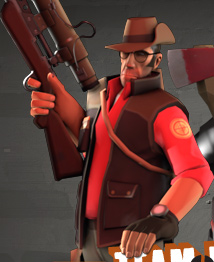

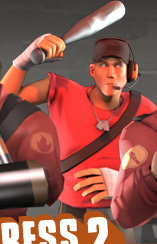
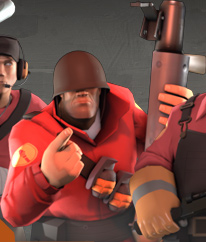
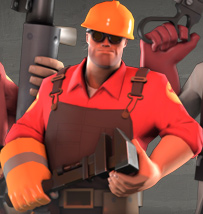
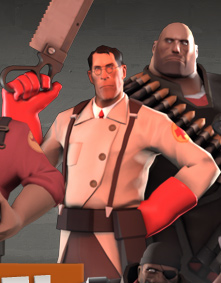
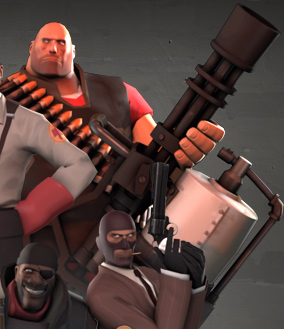
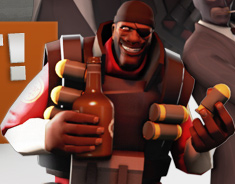
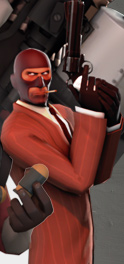
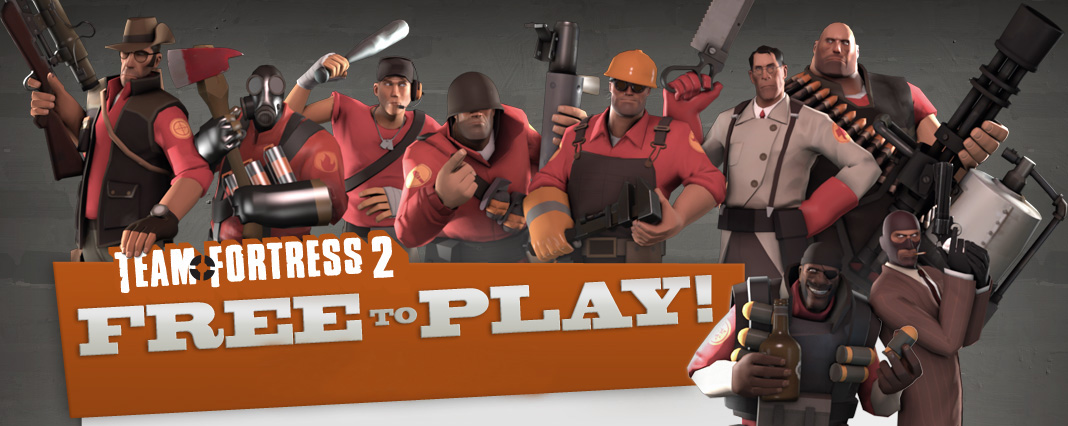
For general feedback about the game.
Steam SupportVisit the support site for any issues you may be having with the game or Steam.
Work on the next class pack is gearing up, a little slower than we'd like. In the meantime, I thought I'd post some answers to the common email questions we receive.
How do respawn waves work? Is my respawn time affected by my performance? Why do they exist at all?
Respawn waves occur on regular intervals, based on the map settings. Most of our maps use a 10 second respawn wave time. That 10 seconds is then modified by the map state, generally reduced for the team that controls the most capture points. Each team's respawn wave time is then scaled down if the team has less than 8 players in it, to a minimum of 5 seconds if team has 3 or less players in it. When you die, you are assigned to the respawn wave after the next one. So if the respawn wave time is currently 10 seconds for your team, you'll respawn somewhere between 10 and 20 seconds from your death. Your individual performance doesn't affect your respawn time in any way.

We found respawn waves were a good solution to several problems.
Well, it's been a couple of weeks since we updated the blog, and we thought it was time to let you know why we've been so quiet. The last couple of weeks we've actually been moonlighting on Left 4 Dead. While the L4D team has been focusing on finishing up the core cooperative gameplay, we've been helping them by working on their Versus mode. Versus is the recently-announced competitive mode where one team plays the Survivors and one team plays the Infected. We've learned a lot while working on TF2 in the last year, and we were able to apply some of those lessons to Versus mode. As a result, we've just finished adding critical hits, respawn waves, flawless auto-team balancing, and facestabs to L4D, while removing anything that looked remotely like a grenade.
I kid, I kid.

Now that we're wrapping up that work, we'll be returning to TF2. We've got a bunch of exciting changes coming down the pipe for the next class update. Feels good to be home again!
The path to arriving at a final design for a character is sometimes a long and winding one. This was especially the case for the Demoman and we thought it would be interesting to step through that process and shed a little light on how we arrive at our final designs. Early on in the process, soon after we decided that we were going to start a new, more stylized direction for TF2 it opened up a whole range of possibilities in terms of what that meant visually. One of the first (albeit short-lived) ideas that was being thrown around was to try to recreate a look of claymation for our game. The idea was to make the world look like a miniature set built for clay figures which animated and gibbed into chunks of clay.

A quick set of concepts were made to test the idea but we quickly realized that though the novelty of such a direction would be interesting, it didn't fit some of our higher level goals in terms of what kind of product we were trying to deliver. However, we did want to hold onto this concept of simulating real world artistic materials in the game and this led to the more painterly look which eventually shipped with the product.
Now that we were back to the drawing board an effort was made to first think of these classes as full characters with a history, distinct personalities and even nationalities. Short biographies were drafted which helped the artists concept characters which they imagined would match these biographies. For the Demoman, although the angry Scotsman was already an archetype common in media we decided to embrace that. The short bio was:
With this bio to springboard from and constant meetings between the artists and feedback from the team, a number of concepts were created:






As we were designing the characters, a stronger emphasis was simultaneously being placed on readability of the classes when playing the game, and so as you can see in the examples above, the silhouette of the Demoman was becoming more and more distinct. The first few concepts didn't really separate him out from the rest of the classes but as he was refined the more substantial upper body shape helped make him recognizable immediately.
At this point, the 3D model for the Demoman was being built and we were preparing to move on. However, there were still some who didn't think he was quite there. A nagging feeling that perhaps the embracing of the archetype was a little to generic. Perhaps a little too much like a groundskeeper in Springfield. We needed a twist to make him more interesting. We didn't want to lose his personality but felt like visually he needed something that broke the cliche. A suggestion was made to have him of African descent and we ran with it.



With a few modifications to his overall shape we soon arrived at the final concept and what you all see and play in the game today:

We decided to create a new TF environment after sensing some desert-fatigue, both internally and externally. The new theme had to be a departure from the current look without being so different that the characters felt out of place in it. We also wanted to leverage some content from our existing environments, since crafting every asset from scratch would mean we'd be moving the release beyond Valve time and into the realm of geologic time. Given these goals and constraints, we settled on the Alpine theme for two reasons: Its green foliage and blue-gray rocks let us introduce a new, cooler color palette to the game, and the lumber mill / mining camp buildings fit our existing set of structures. For Arena Lumberyard, the goal was to establish a clear difference between the two sides of the map. One side climbs up toward a large mountain peak, and the other dips down into a vast valley. We're excited to have a new visual theme to play with, and we'll definitely be using it in future maps.


We've been a little quiet for the last week as we've put the finishing touches on the Heavy update. We thought the Pyro pack was the biggest we'd be doing for a while, due to the large changes to the Pyro, but the Heavy update has turned out to be even bigger. In addition to the three unlockable weapons and thirty-five achievements for the Heavy, we've got a new game mode with five new arenas for it, a new Payload map focusing on more open spaces than Goldrush, and another popular community-made map. Throughout the rest of the week we'll be giving you the details on all this, and if all goes well, you'll have your hands on it shortly afterwards.
The community-made map included in the Heavy update is cp_steel, by Jamie 'Fishbus' Manson. After the Pyro update we received a lot of email telling us how wrong we were in our choices, and cp_steel was an easy next choice due to the way it dominated the suggestions. If you're firing up your email right now to tell us that we never get anything right, please include suggestions of what map(s) we should be looking at next.
We'll be updating A Heavy Update site with more info daily. Stay tuned!